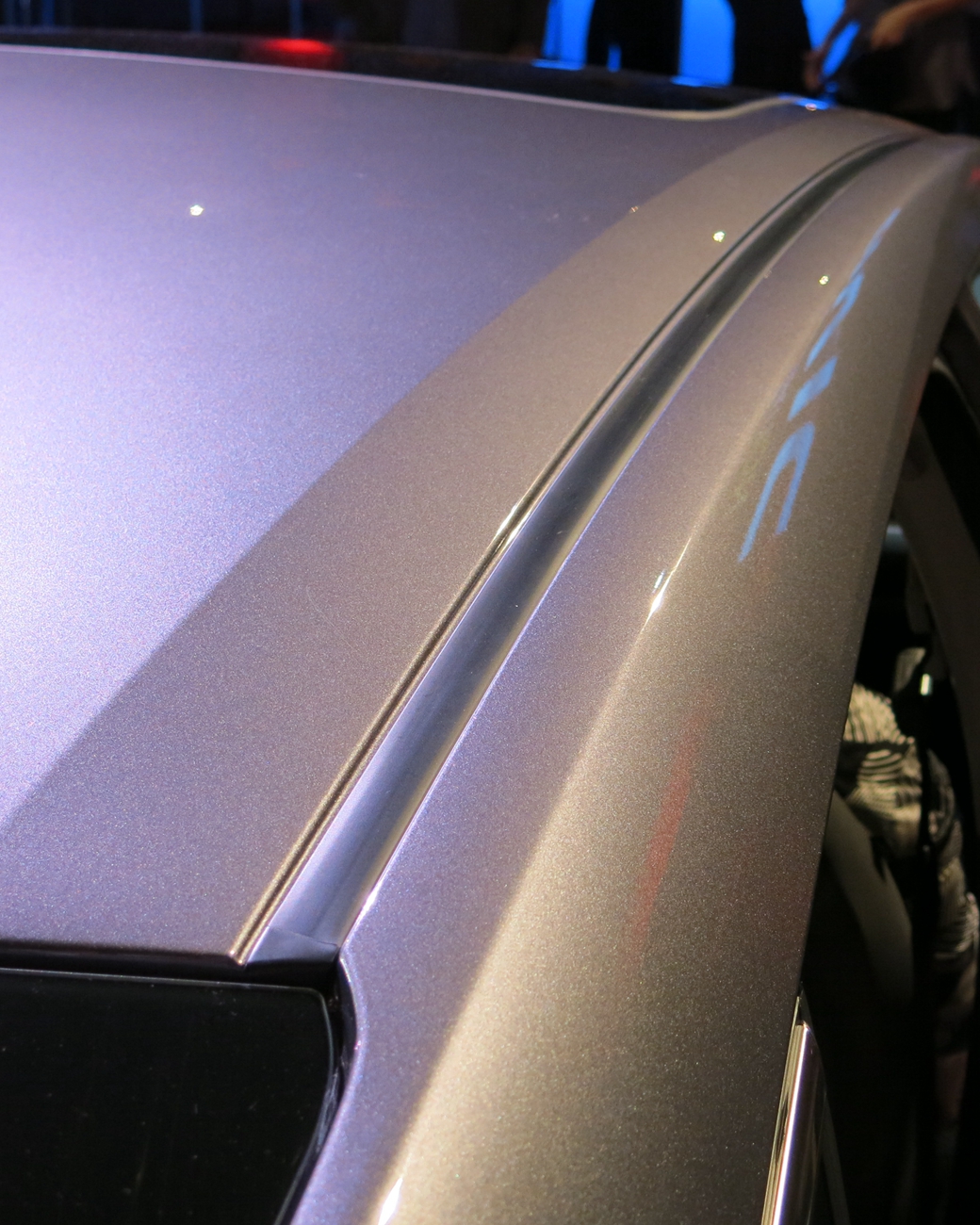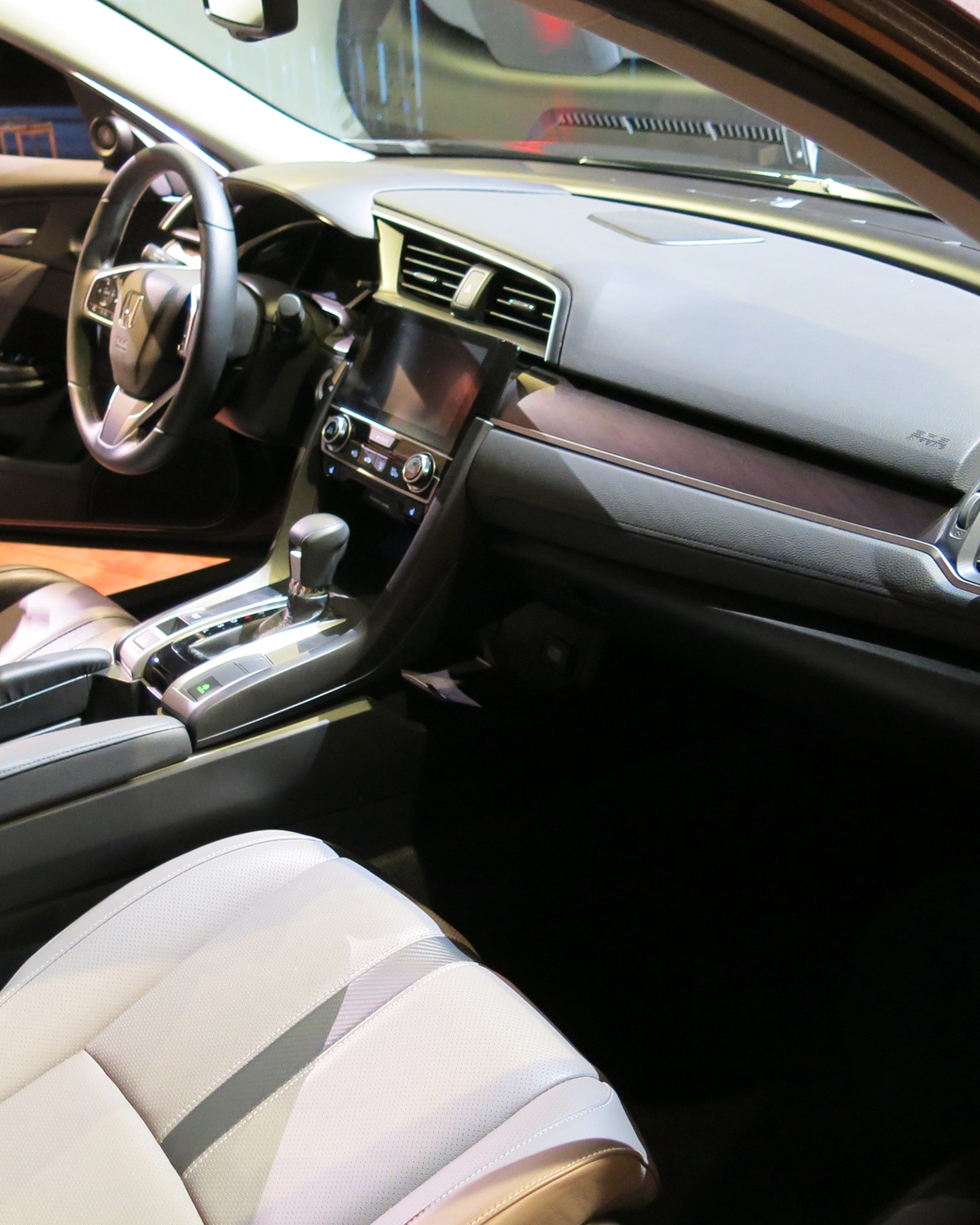 本田美国执行副总裁John Mendel在9月16日底特律的媒体披露会上介绍全新的2016思域轿车。
本田美国执行副总裁John Mendel在9月16日底特律的媒体披露会上介绍全新的2016思域轿车。 新思域后部四分之一的照片显示出这辆C级轿车具有更大的车身比例、充满雕塑感的车身板和更小的侧窗。
新思域后部四分之一的照片显示出这辆C级轿车具有更大的车身比例、充满雕塑感的车身板和更小的侧窗。 新思域车顶至侧面的结构
新思域车顶至侧面的结构 大型LED尾灯为新车型的时尚风格增色不少。
大型LED尾灯为新车型的时尚风格增色不少。 2016思域的驾驶舱提升了人体工程学设计。驾驶员的H点比旧版更低,底板、仪表板和发动机架也进行了相应的降低。
2016思域的驾驶舱提升了人体工程学设计。驾驶员的H点比旧版更低,底板、仪表板和发动机架也进行了相应的降低。 本田电子设计师将思域的仪表显示设计得简单易读。
本田电子设计师将思域的仪表显示设计得简单易读。 新思域的内部空间比旧版宽敞许多。后座的座椅与头部空间以及脚部空间甚至可以轻松容纳2米高的乘客。
新思域的内部空间比旧版宽敞许多。后座的座椅与头部空间以及脚部空间甚至可以轻松容纳2米高的乘客。 以奥迪A3和梅赛德斯CLA为基准,本田全面升级了新思域的车身与装饰件材料。
以奥迪A3和梅赛德斯CLA为基准,本田全面升级了新思域的车身与装饰件材料。
为打造2016思域,本田几乎倾其全力。此次在第10代思域上所花的心思,体现出本田致力于提升全球C级车水准的决心。新思域在很多方面都有显著提升,包括子结构上的4连杆独立后悬架、液压悬架衬套、更强大的NVH弱化技术、以及内饰设计、材料和整体装潢等。
在9月16日底特律与洛杉矶的媒体披露会上,本田美国执行副总裁 John Mendel揭开了新思域的面纱。其实它属于一个全新的车型系列,该系列还将包括一辆双门轿跑、五门两厢车、运动版Si和高性能的R车型。
“这个平台于2012年初启动,在研发这辆车的时候,我们的目标不仅是思域这个级别中的竞争对手,我们更希望做到全方位的最佳水平,而不是局限于该级别的评价标准。这是一个野心勃勃的计划,” Mendel告诉《汽车工程杂志》。他说奥迪A3是最主要的竞争对手,此外还有梅赛德斯CLA。Mendel坦承目前的思域是公司的遗憾,因为外界普遍批评其使用了廉价的内饰材料,而且失去了本田独有的驾驶乐趣。从1973年以来,这种良好的感觉已帮助本田卖出了4000万辆车。
这也是第一辆真正意义上的全球性的本田思域,全世界各地都使用相同的架构、生产流程和材料。而上一代思域的许多细节在北美、欧洲和亚洲各不相同。
《汽车工程杂志》在2015年初也报道过(见http://articles.sae.org/14040/),2016款思域是本田第一辆采用全新的“全球紧凑平台”的车型,该平台也将成为下一代雅阁和HR-V跨界车的基底。位于俄亥俄州雷蒙德地区的本田研发中心的工程师们指出,公司产量最高的两个平台的结合,将使产量提升数百万台。
这一由俄亥俄团队牵头,并由资深项目经理Mitsura Kariya管理的项目还采用了一种全新的采购部件与系统的模块化方案。这个采购计划可以极大地促进本田对全球供应商的利用,在过去的供应商之外开拓更广阔的天地。
新思域的轴距比旧版长了1.2英寸(30.5mm),宽了近2英寸(50mm)。
新思域将提供2种全新的动力系统选项。第一种是配有最新的i-VTEC 气门机构的2.0L自然吸气四缸发动机,可搭配6速手动变速箱或无极自动变速箱(CVT)。第二种是1.5L直喷涡轮发动机,也是本田成品车中首次使用的增压发动机,它只能搭配CVT。两种选项中的CVT都是在位于俄亥俄州Russells Point的本田工厂中生产的。Mendel没有提供关于动力系统的更多细节,只提到燃油经济性数据将“比40 mpg高一些”。
新思域采用了本田称之为ACE(高级兼容性工程)的最新车身结构,据称该结构的抗扭强度比旧版高出26%,因为材料中包含了12%的超高强度钢材。在早期规划中,本田就打算回归其经典的低前围板驾驶位置设计。为此,本田将驾驶员的H点降低20mm(0.8英寸),这也是奥迪TT的水平。地板、仪表板和发动机架也进行了相应的降低。据称,车内空间增加了3.7立方英尺(105 L),腿部空间增加了2英寸(51毫米)。行李箱体积比2015版多了2.6立方英尺(74 L)
新思域的综合安全系统采用了“本田传感”主动安全技术,其中包括首次在思域上使用的适应性巡航控制与低速跟进技术。
面向北美客户的新思域将在位于安大略州阿里斯顿与印第安纳州格林斯堡的组装工厂生产。发动机将在俄亥俄州安娜市的工厂中生产。
《汽车工程杂志》将继续报道有关新思域研发与技术的全面细节。
作者:Lindsay Brooke
来源:SAE《汽车工程杂志》
翻译:SAE 上海办公室
Honda’s all-new global 2016 Civic targets Mercedes refinement
Honda appears to have committed the resources where it counted to create the 2016 Civic. With a 4-link independent rear suspension mounted on a subframe, hydraulic suspension-compliance bushings, increased use of NVH attenuation techniques, and a visibly significant upgrade in interior design, materials, and overall finish, Honda’s 10th-generation Civic shows the automaker’s seriousness in raising the bar in the global C-segment.
American Honda Executive Vice President John Mendel unveiled the Civic sedan—part of an all-new model range that will also include a 2-door coupe, 5-door hatch, sporty Si, and high-performance Type R—at media events in Detroit and L.A. on Sept. 16.
“In developing this car—the platform was signed off in early 2012—we targeted not just the best competitors in the Civic’s segment but the best overall, regardless of segment. This was a very ambitious program,” Mendel told Automotive Engineering. He said Audi’s A3 was the primary competitive bogey, along with theMercedes CLA. Mendel frankly admitted that the incumbent Civic was a disappointment to the company, being widely criticized for its use of cheapened interior materials and a perceived loss of the fun-to-drive character that helped Honda sell over 40 million examples since 1973.
This also is Honda’s first truly global Civic, sharing a common architecture, build process, and bill of material in all regions. Previous-generation Civics differed in many details between North America, Europe, and Asia, he said.
As reported in early 2015 by Automotive Engineering (seehttp://articles.sae.org/14040/), the 2016 Civic is Honda’s first application of its new Global Compact vehicle platform that will also underpin the next-generation Accord and HR-V crossover. Engineers working at the Raymond, OH, R&D complex noted that consolidating the company’s two highest-volume vehicle platforms will dramatically boost production scale, by millions of units.
The program, which was spearheaded by the Ohio team and led by veteran program manager Mitsura Kariya, also integrates a new modular approach to components and systems. The new sourcing plan greatly expands Honda’s use of global vendors, going farther outside the kieretsu than ever before.
The new model rides on a wheelbase that is 1.2 in (30.5 mm) longer and nearly 2 in (50 mm) wider than the outgoing car.
Two all-new powertrains will be available: a 2.0-L naturally-aspirated four featuring the latest i-VTEC valvetrain, offered with either a 6-speed manual or CVT (continuously variable transmission); and a 1.5-L direct-injected turbo engine, the first boosted engine offered in a production Honda, mated only to the CVT, itself to be built at Honda’s Russells Point, OH, factory. Mendel provided no details of the powertrains, other than to say fuel economy would be “several ticks above 40 mpg."
Civic uses the latest version of the company’s so-called ACE (Advanced Compatibility Engineering) body structure that is claimed to be 26% stiffer in torsion than the previous car and incorporates 12% ultra-high-strength steel. Attention was paid during early layout to returning to the classic Honda low-cowl driving position. To achieve this, the driver’s H-point was lowered by 20 mm (0.8 in) to bring it to the same level as Audi’s TT. Height of the floorpan, instrument panel, and engine mounts were commensurately reduced. Cabin volume is increased by a claimed 3.7 ft3 (105 L), with 2 in (51 mm) more rear legroom. Trunk space is 2.6 ft3 (74 L) larger than that of the 2015 model.
The comprehensive safety suite features available “Honda Sensing” active technologies including, for the first time on Civic, adaptive cruise control with a low-speed follow feature.
The new Civic will be built at Honda’s Alliston, Ont., and Greensburg, IN, assembly plants for North American customers. Engines will come out of Anna, OH.
Automotive Engineering will have full details of the car’s development and technologies in an upcoming issue.
Author: Lindsay Brooke
Source: SAE Automotive Engineering Magazine
等级
打分
- 2分
- 4分
- 6分
- 8分
- 10分
平均分
